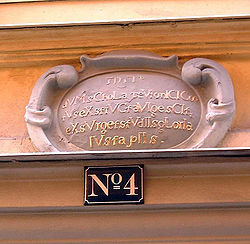
Tyska Skolgränd
Encyclopedia

Alley
An alley or alleyway is a narrow lane found in urban areas, often for pedestrians only, which usually runs between or behind buildings. In older cities and towns in Europe, alleys are often what is left of a medieval street network, or a right of way or ancient footpath in an urban setting...
in Gamla stan
Gamla stan
Gamla stan , until 1980 officially Staden mellan broarna , is the old town of Stockholm, Sweden. Gamla stan consists primarily of the island Stadsholmen. The surrounding islets Riddarholmen, Helgeandsholmen, and Strömsborg are officially part of, but not colloquially included in, Gamla stan...
, the old town in central Stockholm
Stockholm
Stockholm is the capital and the largest city of Sweden and constitutes the most populated urban area in Scandinavia. Stockholm is the most populous city in Sweden, with a population of 851,155 in the municipality , 1.37 million in the urban area , and around 2.1 million in the metropolitan area...
, Sweden
Sweden
Sweden , officially the Kingdom of Sweden , is a Nordic country on the Scandinavian Peninsula in Northern Europe. Sweden borders with Norway and Finland and is connected to Denmark by a bridge-tunnel across the Öresund....
, stretching from Svartmangatan to Baggensgatan
Baggensgatan
Baggensgatan is a street in Gamla stan, the old town in central Stockholm, Sweden. Forming a southern extension to the street Bollhusgränd near the square Köpmantorget, it stretches to the southern end of Svartmangatan...
, and crossed by Själagårdsgatan
Själagårdsgatan
Själagårdsgatan is a street in Gamla stan, the old town in central Stockholm, Sweden. Stretching south from Köpmangatan to Tyska Brunnsplan, it forms a parallel street to Baggensgatan...
.
The present name of the street, first appearing as Tyska Scholæ Gatan on a map from the early 18th century, is apparently derived from the German school in the late 16th century housed on number 8, Själagårdsgatan. The lot was thereafter bought by the German parish who had a first school building built in 1626, and a new completed in 1670. The building was subsequently enlarged and rebuilt at several occasions, the present buildings on the location mostly dating from 1887. The building, as it seem, was the one in general used by itinerant theatre groups in Stockholm during the 17th century. The German school was discontinued after more than 300 years, but a new German school, still in operation, was inaugurated on Östermalm in 1941.
The part of the alley east of Själagårdsgatan appears under different names reflecting the various activities dominating it: In 1557, it is called Tynnebindare gaten referring to a hooper
Hooper
The word hooper is an archaic English term for a person who aided in the building of barrels by creating the hoop for the barrel. Hooper may also refer to:Place names in the United States:...
(e.g. maker of barrels) Peder Tunnbindare ("Peter Barrel-binder") known to have lived here in 1538. Located on the north side of the alley was, however, the potent Vårfrugillet av den tyska nationen ("Our Lady's guild of the German Nation"), which gave the alley the name Gillestugegaten ("Guild's Cottage's Street") in 1579. During the 18th century, the alley is also referred to as Persiljegränd ("Parsley Alley"), possibly a corruption (jocular or not) of the name of the extended block east of the alley, Perseus
Perseus
Perseus ,Perseos and Perseas are not used in English. the legendary founder of Mycenae and of the Perseid dynasty of Danaans there, was the first of the mythic heroes of Greek mythology whose exploits in defeating various archaic monsters provided the founding myths of the Twelve Olympians...
. Since the revision of street names in 1885, this alley is, however, made part of the western section.

Sandstone
Sandstone is a sedimentary rock composed mainly of sand-sized minerals or rock grains.Most sandstone is composed of quartz and/or feldspar because these are the most common minerals in the Earth's crust. Like sand, sandstone may be any colour, but the most common colours are tan, brown, yellow,...
cartouche
Cartouche (design)
A cartouche is an oval or oblong design with a slightly convex surface, typically edged with ornamental scrollwork. It is used to hold a painted or low relief design....
dating back to the 1670s and displaying the message:
- "dVM sChoLa teVton ICI CoetVs eXstrVCta VIgesCIt, eXsVrget StVdIIs gLorIa IVsta pIIs"
a Latin sentence meaning "As long as the school of the German parish prosper, conscientious studies will bring true honour". The Latin numbers in the sentence - an encrypted message - summon up to the year 1670.
See also
- List of streets and squares in Gamla stan
- German ChurchGerman Church, StockholmTyska kyrkan , sometimes called St. Gertrude's Church , is a church in Gamla stan, the old town in central Stockholm, Sweden....
External links
- Stockholmskällan - A historical photo from 1905
- http://www.hitta.se/SearchCombi.aspx?__VIEWSTATE=%2FwEPDwUKMTg4NDI3NTMzNWRk&UCSB%3AWflWhite=1a1b&UCSB%3AWflPink=4a&SearchType=4&UCSB%3ABBX1=&UCSB%3ABBY1=&UCSB%3ABBX2=&UCSB%3ABBY2=&UCSB%3ATextBoxWho=&UCSB%3ATextBoxWhere=Tyska+Skolgr%E4nd&UCSB%3AButtonSearch=%A0%A0hitta%21%A0%A0&CombiDetails%3AMapControl%3Acx=1628658&CombiDetails%3AMapControl%3Acy=6580579&CombiDetails%3AMapControl%3ApointsHidden=&CombiDetails%3AMapControl%3Az=3hitta.se - Location map and virtual walk]
- German School, Stockholm

